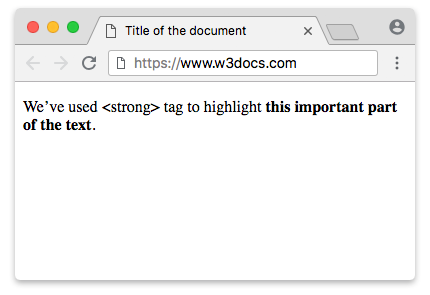The <strong> tag highlights an important part of a text. It can be used for such important contents, as warnings. This can be one sentence that gives importance to the whole page, or it may be needed if you want to highlight some words that are of greater importance compared to the rest of the content. The content of the tag has higher weight for the search engines and the devices, while reading emphasizes the content only with special intonation.
The <strong> tag is a phrase tag indicating that a text section has structural meaning.
The content of the tag is displayed as bold. Unlike the <b> tag, which specifies bold text, the <strong> tag is a part of semantic markup. The <b> tag is used to bring attention to the text without specifying that it is more important. In most browsers, the default styling for both the <b> and <strong> tags is the same. However, if you want to have bold text just for decoration, you should use the CSS font-weight property.
HTML4 defined the <strong> tag as implying a stronger emphasis. Unlike it, HTML5 defines it as representing strong importance of the content.
As compared to the <em> tag which changes the meaning of a sentence like the spoken emphasis, <strong> gives parts of a sentence that add importance.
Syntax
The <strong> tag comes in pairs. The content is written between the opening (<strong>) and closing (</strong>) tags.
Example of the HTML <strong> tag:
<!DOCTYPE html>
<html>
<head>
<title>Title of the document</title>
</head>
<body>
<p>We’ve used <strong> tag to highlight <strong> this important part of the text</strong>.</p>
</body>
</html>Result

Attributes
The <strong> tag supports Global Attributes and the Event Attributes.
How to style <strong> tag?
Common properties to alter the visual weight/emphasis/size of text in <strong> tag:
- CSS font-style property sets the style of the font. normal | italic | oblique | initial | inherit.
- CSS font-family property specifies a prioritized list of one or more font family names and/or generic family names for the selected element.
- CSS font-size property sets the size of the font.
- CSS font-weight property defines whether the font should be bold or thick.
- CSS text-transform property controls text case and capitalization.
- CSS text-decoration property specifies the decoration added to text, and is a shorthand property for text-decoration-line, text-decoration-color, text-decoration-style.
Coloring text in <strong> tag:
- CSS color property describes the color of the text content and text decorations.
- CSS background-color property sets the background color of an element.
Text layout styles for <strong> tag:
- CSS text-indent property specifies the indentation of the first line in a text block.
- CSS text-overflow property specifies how overflowed content that is not displayed should be signalled to the user.
- CSS white-space property specifies how white-space inside an element is handled.
- CSS word-break property specifies where the lines should be broken.
Other properties worth looking at for <strong> tag:
- CSS text-shadow property adds shadow to text.
- CSS text-align-last property sets the alignment of the last line of the text.
- CSS line-height property specifies the height of a line.
- CSS letter-spacing property defines the spaces between letters/characters in a text.
- CSS word-spacing property sets the spacing between words.
Browser support
|
|
|
|
|
|
|---|---|---|---|---|
| ✓ | ✓ | ✓ | ✓ | ✓ |
Practice Your Knowledge
Quiz Time: Test Your Skills!
Ready to challenge what you've learned? Dive into our interactive quizzes for a deeper understanding and a fun way to reinforce your knowledge.